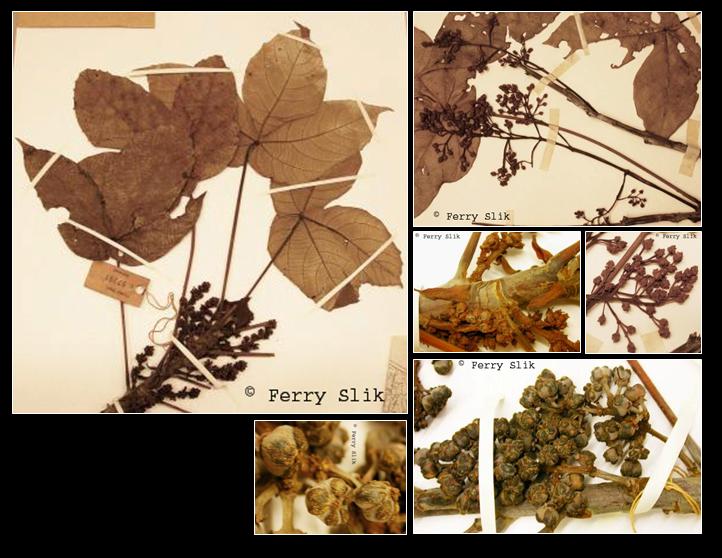Macaranga hypoleuca (Reichb.f. & Zoll.) Mull.Arg., in DC., Prodr. 15, 2 (1866)
Latin for 'white underside'.Synonyms
Mappa hypoleuca Reichb.f. & Zoll.
Tanarius hypoleucus (Rchb.f. & Zoll.) Kuntze
Diagnostics
Sub-canopy tree up to 29 m tall and 42 cm dbh. Twigs hollow, ant inhabited,
glaucous. Stipules ca. 12 mm long. Leaves alternate, simple, 3-lobed, peltate,
palmately veined, glabrous, whitish below. Flowers ca. 0.5 mm diameter,
greenish, placed in bundles within bracts which are part of large branched
inflorescences. Fruits ca. 7 mm diameter, green-whitish, 3-lobed, dehiscent
capsules, seeds with red aril.
Description
Tree to 30 m tall and 30-40 cm dbh, flowering somewhat smaller; twigs 7-12(-14) mm in diam.,
slightly angular at the apex especially when dry, glabrous or with scattered minute ferrugineus
hairs towards the apex, intensely glaucous white. Bark bluish-green white and glaucous when young
to pale brown, prominently hoop-marked, quite smooth. Stipules deltate, c. 1 by 0.7 cm, thickly
coriaceous, spreading perpendicularly to the stem, glabrous or with scattered minute ferrugineus
hairs at the base, glaucous, persistent or sometimes caducous. Leaves: petioles terete, slender,
10-30 cm long, glabrous, glaucous; blades broader than long to almost rounded, usually slightly
convex, 10-24 by 12-30 cm, deeply trilobed to c. 3/4 of length, rarely with additional basal cusps,
the three lobes subequal with the central lobe only slightly longer and broader than the laterals,
deeply peltate to 1.5-4 cm, base broadly rounded sometimes slightly cordate, margin entire sometimes
with tiny protruding conical nectaries, apices acute or shortly acuminate, adaxial surface glabrous,
abaxial surface white and intensely glaucous with scattered ferrugineus hairs on the veins; 1st
degree venation palmate with 8-10 prominent veins, 2nd degree venation strongly looping and sometimes
ending in prominent conical nectaries at the leaf margin, 3rd degree veins scalariform, 4th degree
and finer veins indistinct due to white wax and not or only weakly scalariform; young leaves dark
red-rown, densely covered in minute ferrugineus hairs and scattered with long silvery hairs, soon
becoming glabrous, producing food-bodies on lower surface. Staminate inflorescences erect panicles,
to 10-28(-35) cm long, up to 4 axis orders, branching from less than 1/2 axis length, main axis
flattened, first pair of secondary branches +/- opposite with accessory branches, basal axes
glabrous densely glaucous, distal axes moderately to densely covered in crisped ferrugineus hairs;
bracts deltate, 3-6 mm long, margin entire, both surfaces scattered with minute ferrugineus hairs;
bracteoles ovate, 2.5-4 by c. 3 mm, enclosing the flower clusters, margin finely evenly pectinate
with more than 10 short appressed teeth, apex acute, both surfaces densely covered in minute
ferrugineus hairs. Staminate flowers 10-15 per cluster, c. 1 mm long, shortly pedicellate; sepals
3, fused, densely covered in minute ferrugineus hairs; stamens 1; anthers 4-locular. Pistillate
inflorescences 5-15 cm long, 2 axis orders, branched from near the base, branches short, densely
glaucous, basal axes glabrous to scattered with minute ferrugineus hairs, distal axes densely
ferrugineus pubescent; bracts ovate-elliptic, 5-7 mm long, entire or with a finely pectinate apex,
covered in ferrugineus hairs, caducous. Pistillate flowers c. 2-3 mm long; calyx urceolate, c. 1 mm
long, glaucous with minute ferrugineus hairs, ovary 3-carpellate; styles c. 1mm long, free,
persistent. Fruits 3-locular, sub-globose, 5-6 by 6-8 mm, bluish-green, glaucous, two discrete
glandular patches on each carpel wall developing into slightly raised disc-like ridges, covered in
bright yellow, sticky exudate; pedicel 3-11 mm long, glaucous, with scattered minute crisped
ferrugineus hairs. Seeds 3-4 mm in diam., spheroidal to slightly flattened, black, with large round
shallow pits, encased in a fleshy bright red aril. [from Flora Malesiana]
Ecology
A common and widespread early successional tree. It grows in a wide range of habitats from the
lowlands to around 1000 m. It occurs mostly in dryland dipterocarp forests but may also be seen on
the edges of swampy forests. It appears to be quite tolerant of a range of soil conditions and can
be found on richer shale-derived soils as well as on sandstone-derived soils. While this species
flowers at relatively small sizes, it grows to over 30 m in height and is one of the largest pioneer
trees in section Pachystemon. It is very high-light demanding and colonizes forests after selective
logging, and regenerates abundantly following shifting agriculture.
Uses
The wood is used for house building.
Distribution
Peninsular Thailand, Peninsular Malaysia, Sumatra, Borneo.
Local names
Borneo: Bettotan, Garung semut, Menuah, Padaan, Padahan, Purang romang, Sedaman.
